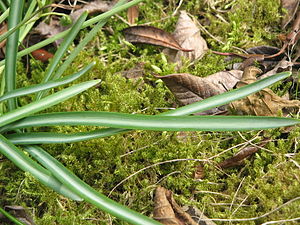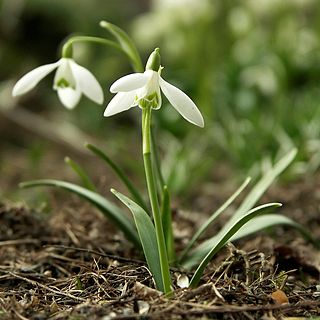
Galanthus, or snowdrop, is a small genus of approximately 20 species of bulbous perennial herbaceous plants in the family Amaryllidaceae. The plants have two linear leaves and a single small white drooping bell-shaped flower with six petal-like (petaloid) tepals in two circles (whorls). The smaller inner petals have green markings.

Leucojum is a small genus of bulbous plants native to Eurasia belonging to the amaryllis family, subfamily Amaryllidoideae. As currently circumscribed, the genus includes only two known species, most former species having been moved into the genus Acis. Both genera are known as snowflakes.

Strelitzia reginae, commonly known as the crane flower, bird of paradise, or isigude in Nguni, is a species of flowering plant native to the Cape Provinces and KwaZulu-Natal in South Africa. An evergreen perennial, it is widely cultivated for its dramatic flowers. In temperate areas it is a popular houseplant.
A galanthophile is an enthusiastic collector and identifier of snowdrop (Galanthus) species and cultivars.

Galanthus nivalis, the snowdrop or common snowdrop, is the best-known and most widespread of the 20 species in its genus, Galanthus. Snowdrops are among the first bulbs to bloom in spring and can form impressive carpets of white in areas where they are native or have been naturalised. They should not be confused with the snowflakes, in the genera Leucojum and Acis.
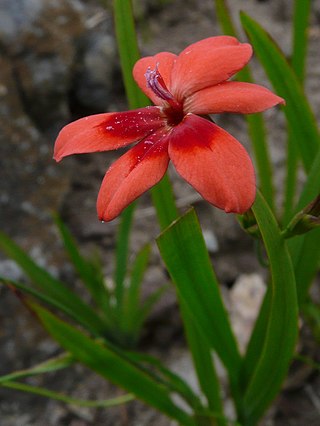
Freesia laxa, commonly known as flowering grass, is a small species of cormous flowering plant in the family Iridaceae, from eastern and southern Africa, from Kenya to northeastern South Africa. It is grown in gardens as an ornamental plant.
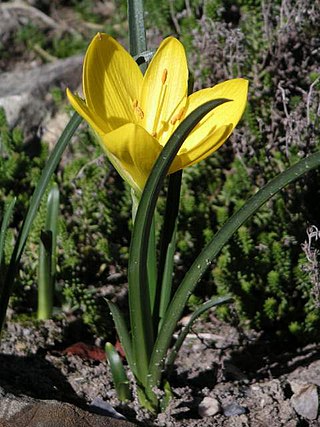
Sternbergia lutea, the winter daffodil, autumn daffodil, fall daffodil, lily-of-the-field, or yellow autumn crocus, is a bulbous flowering plant in the family Amaryllidaceae, subfamily Amaryllidoideae, in the Narcisseae tribe, which is used as an ornamental plant. It has yellow flowers which appear in autumn.
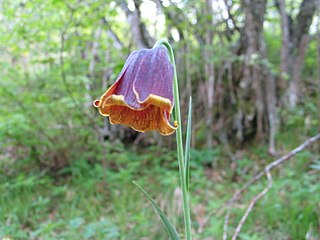
Fritillaria pyrenaica is a species of flowering plant in the lily family Liliaceae, native to the Pyrenees in Spain and France. Common names include Pyrenean fritillary and Pyrenean snake's-head. It is a bulbous perennial growing to 45 cm (18 in). The pendent, bell-shaped flowers are borne in spring. They have recurved tepals which are purple tinged with brown and yellow. Like other species in this genus, notably F. meleagris, they are strongly chequered.
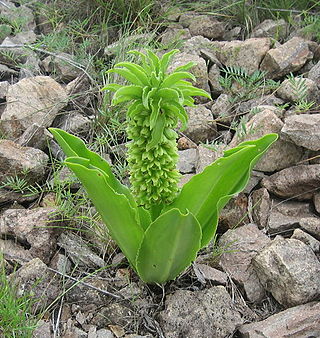
Eucomis autumnalis, the autumn pineapple flower, or autumn pineapple lily, is a species of flowering plant in the family Asparagaceae, subfamily Scilloideae, native to Malawi, Zimbabwe and southern Africa. It is a mid to late summer flowering deciduous bulbous perennial. The flower stem reaches about 40 cm (16 in), rising from a basal rosette of wavy-edged leaves. The green, yellow or white flowers are arranged in a spike (raceme), topped by a "head" of green leaflike bracts. It is grown as an ornamental garden plant and can also be used as a cut flower.
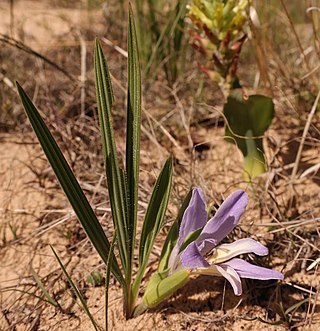
Babiana nana is a species of geophyte of 6–15 cm (2.4–5.9 in) high that is assigned to the family Iridaceae. It has leaves that consist of a sheath and a blade that are at an angle with each other. The leaf blades are oval to almost line-shaped and have a left and right surface, rather than an upper and lower surface. The leaf blades are moderately pleated and covered in dense, soft hairs. The inflorescence contains two to six blue to violet or pale pink flowers adorned with white markings on the lower lip, and with three stamens crowding under the upper lip. Flowering occurs from late August to the end of September. The flowers emit a smell reminiscent of roses or violets.

Leucojum aestivum, commonly called summer snowflake or Loddon lily, is a plant species widely cultivated as an ornamental. It is native to most of Europe from Spain and Ireland to Ukraine, with the exception of Scandinavia, Russia, Belarus and the Baltic countries. It is also considered native to Turkey, Iran and the Caucasus. It is naturalized in Denmark, South Australia, New South Wales, Nova Scotia and much of the eastern United States.
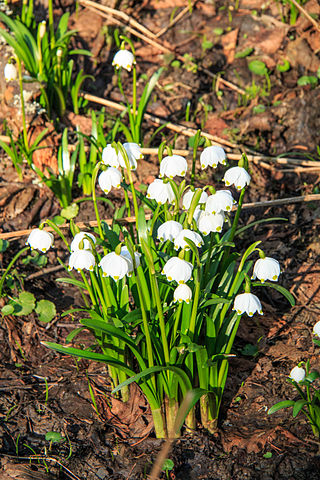
Leucojum vernum, called the spring snowflake, is a species of flowering plant in the family Amaryllidaceae. It is native to central and southern Europe from Belgium to Ukraine. It is considered naturalized in north-western Europe, including Great Britain and parts of Scandinavia, and in the US states of Georgia and Florida. This spring flowering bulbous herbaceous perennial is cultivated as an ornamental for a sunny position. The plant multiplies in favourable conditions to form clumps. Each plant bears a single white flower with greenish marks near the tip of the tepal, on a stem about 10–20 cm (3.9–7.9 in) tall, occasionally more.
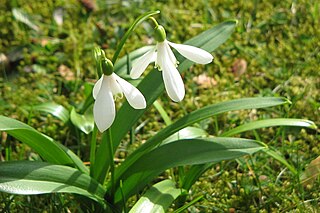
Galanthus woronowii, the green snowdrop or Woronow's snowdrop, is a bulbous plant native to north-east Turkey and the west and central Caucasus. In cultivation particularly, it has often been confused with two other species with broad green leaves and a single green mark on the inner tepals: Galanthus ikariae and Galanthus platyphyllus.

Galanthus elwesii, Elwes's snowdrop or greater snowdrop, is a species of flowering plant in the family Amaryllidaceae, native to the Caucasus.

Acis autumnalis, the autumn snowflake, is a species of flowering plant in the family Amaryllidaceae. A short bulbous perennial, it is found on the western shores of the Mediterranean, from Portugal, Spain and Morocco to Sicily and Tunisia.
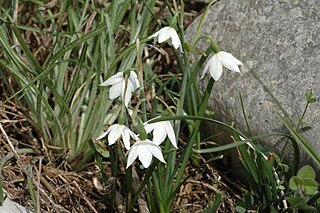
Acis nicaeensis, sometimes called the French snowflake, is a species of flowering plant in the family Amaryllidaceae, native to south-eastern France. A small spring flowering bulb with white flowers, it is cultivated as an ornamental plant.
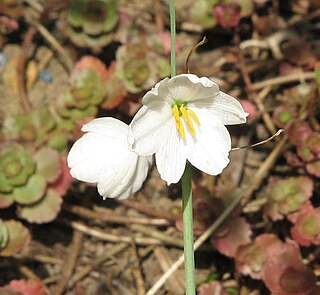
Acis valentina is a species of bulbous flowering plant in the family Amaryllidaceae, native to eastern Spain. Its white flowers appear in autumn. It can be grown as an ornamental bulb, but may need protection from hard frost.
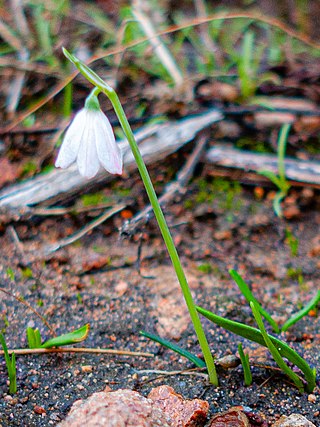
Acis rosea, known as the rose snowflake, is a species of flowering plant in the family Amaryllidaceae, native to Corsica and Sardinia. Unlike most members of the genus Acis, it has pink rather than white flowers. It is grown as an ornamental plant but requires protection from frost.

Galanthus plicatus, the pleated snowdrop, is a species of flowering plant in the family Amaryllidaceae, native to eastern Europe and western Asia. It is a spring flowering bulbous herbaceous perennial.
Eucomis amaryllidifolia is a species of flowering plant in the family Asparagaceae, subfamily Scilloideae, native to the Cape Provinces. It is a short, summer-flowering bulbous plant, with a dense spike (raceme) of yellowish-green flowers topped by a "head" of leafy bracts. In Afrikaans it is called kliplelie.



